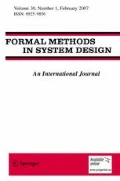Abstract
Multi-Terminal Binary Decision Diagrams (MTBDDs) are a well accepted technique for the state graph (SG) based quantitative analysis of large and complex systems specified by means of high-level model description techniques. However, this type of Decision Diagram (DD) is not always the best choice, since finite functions with small satisfaction sets, and where the fulfilling assignments possess many 0-assigned positions, may yield relatively large MTBDD based representations. Therefore, this article introduces zero-suppressed MTBDDs and proves that they are canonical representations of multi-valued functions on finite input sets. For manipulating DDs of this new type, possibly defined over different sets of function variables, the concept of partially-shared zero-suppressed MTBDDs and respective algorithms are developed. The efficiency of this new approach is demonstrated by comparing it to the well-known standard type of MTBDDs, where both types of DDs have been implemented by us within the C++-based DD-package JINC. The benchmarking takes place in the context of Markovian analysis and probabilistic model checking of systems. In total, the presented work extends existing approaches, since it not only allows one to directly employ (multi-terminal) zero-suppressed DDs in the field of quantitative verification, but also clearly demonstrates their efficiency.
Similar content being viewed by others
References
Formal Methods in System Design (1997) 10(2–3). Special Issue on Multi-Terminal Binary Decision Diagrams
Akers SB (1978) Binary decision diagrams. IEEE Trans Comput C-27(6):509–516
Balbo G, Conte G, Donatelli S, Franceschinis G, Ajmone Marsan M, Ajmone Marsan M (1995) Modelling with generalized stochastic Petri nets. Wiley, New York
Bryant RE (1986) Graph-based algorithms for Boolean function manipulation. IEEE Trans Comput C-35(8):677–691
Ciardo G, Lüttgen G, Miner AS (2007) Exploiting interleaving semantics in symbolic state-space generation. Form Methods Syst Des 31(1):63–100
de Alfaro L, Kwiatkowska M, Norman G, Parker D, Segala R (2000) Symbolic model checking for probabilistic processes using MTBDDs and the Kronecker representation. In: Graf S, Schwartzbach M (eds) Proc. of the 6th int. conference on tools and algorithms for the construction and analysis of systems (TACAS’00). LNCS, vol 1785. Springer, Berlin, pp 395–410
Hermanns H, Herzog U, Mertsiotakis V (1998) Stochastic process algebras—between LOTOS and Markov chains. Comput Netw ISDN Syst 30(9–10):901–924
Hermanns H, Kwiatkowska M, Norman G, Parker D, Siegle M (2003) On the use of MTBDDs for performability analysis and verification of stochastic systems. J Log Algebr Program 56(1–2):23–67
JINC BDD package. www.jossowski.de
Kam T, Villa T, Brayton R, Sangiovanni-Vincentelli A (1998) Multi-valued decision diagrams: theory and applications. Mult Valued Log 4(1–2):9–62
Kuntz M, Siegle M, Werner E (2004) Symbolic performance and dependability evaluation with the tool CASPA. In: Proc. of EPEW. LNCS, vol 3236. Springer, Berlin, pp 293–307
Lampka K, Siegle M (2006) Activity-local state graph generation for high-level stochastic models. In: Meassuring, modeling, and evaluation of systems 2006, April 2006, pp 245–264
Lampka K, Siegle M (2006) Analysis of Markov reward models using zero-supressed multi-terminal decision diagrams. In: Proceedings of VALUETOOLS 2006 (CD-edition), October 2006
Lee CY (1959) Representation of switching circuits by binary-decision programs. Bell Syst Tech J 38:985–999
Minato S (1993) Zero-suppressed BDDs for set manipulation in combinatorial problems. In: Proc. of the 30th ACM/IEEE design automation conference (DAC), Dallas (Texas), USA, June 1993, pp 272–277
Minato S (2001) Zero-suppressed BDDs and their applications. Int J Softw Tools Technol Transf 3(2):156–170
Miner A, Parker D (2004) Symbolic representations and analysis of large state spaces. In: Baier Ch, Haverkort B, Hermanns H, Katoen J-P, Siegle M (eds) Validation of stochastic systems, Dagstuhl (Germany), 2004. LNCS, vol 2925. Springer, Berlin, pp 296–338
Möbius web page. www.moebius.crhc.uiuc.edu
Ossowski J, Baier C (2008) A uniform framework for weighted decision diagrams and its implementation. Int J Softw Tools Technol Transf 10(5):425–441
PRISM. www.prismmodelchecker.org
PROMOC modeling tool. www.jossowski.de
Sasao T, Fujita M (eds) (1996) Representations of discrete functions, vol 1. Kluwer Academic, Dordrecht
Shannon CS (2000) Eine symbolische Analyse von Relaisschaltkreisen. In: Ein/Aus. Brinkmann und Bose, Berlin. The article originally appeared with the title: A symbolic analysis of switching circuits in Trans. AIEE 57 (1938), 713
Siegle M (2001) Advances in model representation. In: de Alfaro L, Gilmore S (eds) Proc. of the joint int. workshop, PAPM-PROBMIV 2001, Aachen (Germany). LNCS, vol 2165. Springer, Berlin, pp 1–22
SMART. www.cs.ucr.edu/~ciardo/SMART
Somenzi F (1998) CUDD: Colorado University decision diagram package release
Wegener I (2000) Branching programs and binary decision diagrams. SIAM, Philadelphia
Author information
Authors and Affiliations
Corresponding author
Rights and permissions
About this article
Cite this article
Lampka, K., Siegle, M., Ossowski, J. et al. Partially-shared zero-suppressed multi-terminal BDDs: concept, algorithms and applications. Form Methods Syst Des 36, 198–222 (2010). https://doi.org/10.1007/s10703-010-0095-8
Published:
Issue Date:
DOI: https://doi.org/10.1007/s10703-010-0095-8




